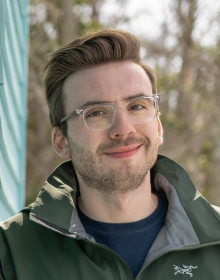Making it count

With technology and a lot of math, Brendan Carswell is using a new method to calculate animal populations and open the field of wildlife management to community involvement.
One of Brendan Carswell’s earliest memories is of a camping trip with his parents. He doesn’t remember all the details because he was so young at the time, but he does recall going for a walk along a forest path with his brother. Little did they know, the two boys were being stalked by a hungry cougar. Luckily a man walking his dogs saw the big cat and managed to scare it off.
Years later, after an unsuccessful day of hunting in the back country, Brendan decided to take a nap outside in the warm British Columbia afternoon. When he woke up, there was a mother grizzly bear and her three cubs foraging about twenty feet away. Brendan simply remained motionless, and undetected, until the animals moved on.
For a lot of people, cougars and grizzlies are good reasons to avoid the wilderness. But for Brendan, wild animals are an inspiration. “The best part of being a wildlife ecologist is interacting with animals,” he says. “It doesn’t have to be close-up interaction, but just seeing animals in their natural habitat is something that’s pretty special.”
Brendan grew up in the small town of Port Hardy, on the northern tip of Vancouver Island. Now he’s a master’s student studying wildlife ecology in the biology department at Memorial University.
He smiles when he says St. John’s is the biggest city he’s ever lived in. But he knows it’s his small-town background that led him here. “I think I kind of got into wildlife because, I mean, I spent most of my time outdoors. We lived in a small town, and we didn’t have a lot to do, so lots of time outside,” he says. “When I realized I could pursue it academically, it was a no-brainer for me.”
These days he spends about four or five months a year in the field. And when asked if he’s worried about wildlife, he clarifies where the real threat lies. “Am I worried about encounters? No. Am I worried about the state of wildlife? Yes,” he says. “There are threats to wildlife in every province in Canada, so there’s definitely lots to be concerned about in that sense.”
The Wildlife Evolutionary Ecology Lab
After completing his undergraduate work at the University of Northern British Columbia, Brendan knew his next move would mean a trip to the other side of the continent. “I came to Memorial primarily for my supervisor, Eric Vander Wal, who is well known all across Canada, and even the world, for his work in wildlife ecology,” he says. “He’s really what drew me here.”
Brendan conducts his research with Vander Wal and the team at the Wildlife Evolutionary Ecology Lab. The lab’s main goal is to translate ecological and evolutionary theory into practical wildlife management and conservation strategies.
One of Brendan’s team members is studying snowshoe hare in Newfoundland. Another is studying elephants in South Africa. Part of Brendan’s research involves counting the moose population in Riding Mountain National Park in Manitoba.
The traditional method of estimating wild animal populations involves flying airplanes over habitats, taking photos, and performing rough head counts. But this tactic is unreliable and causes stress for the animals. Brendan is using camera traps, and a lot of complex math and Bayesian statistics, to be less invasive and more cost effective.
His work is important because while moose are thriving on the island of Newfoundland, that’s not the case everywhere. “In most parts of their range, those populations are declining. There’s a lot of uncertainty as to why that is, and it’s probably a large congregation of multiple factors,” he says, “but it really comes down to human disturbance.”
Counting on communities
What Brendan understands is that his research is a part of a much larger puzzle. “Integrating different knowledge sources is really valuable and something we don’t do enough of,” he says. “Our work is in partnership with many different stakeholders, so we work with different First Nations communities as well as the federal government, through Parks Canada, and provincial governments.”
For Brendan, that kind of collaboration has the most potential. “Having that many different bodies interact is really good for wildlife management,” he says, “because we have people witnessing the populations on the ground, like the First Nations, who are there living on the land, observing declines, or observing patterns of population.”
This information exchange means that researchers can be alerted to potential problems, and people and their communities can be more involved in wildlife management. More engagement means more information, and more information means better solutions.
The research and collaborative experience that Brendan is gaining at Memorial bodes well for his future in the field. “There’s definitely a lot of doors open for me,” he says. “There’s lots of wildlife jobs in Canada. We’re really lucky in that aspect. And of course, I really like to learn. I think the skills that I got here in my lab really have set me up to ask more questions in ecology.”
Eventually, Brendan’s career path will take him elsewhere, but right now, he loves St. John’s and doesn’t want to leave yet. “I’m kind of riding it out as long as I can,” he says.
Become a graduate student at Memorial. Apply online today!